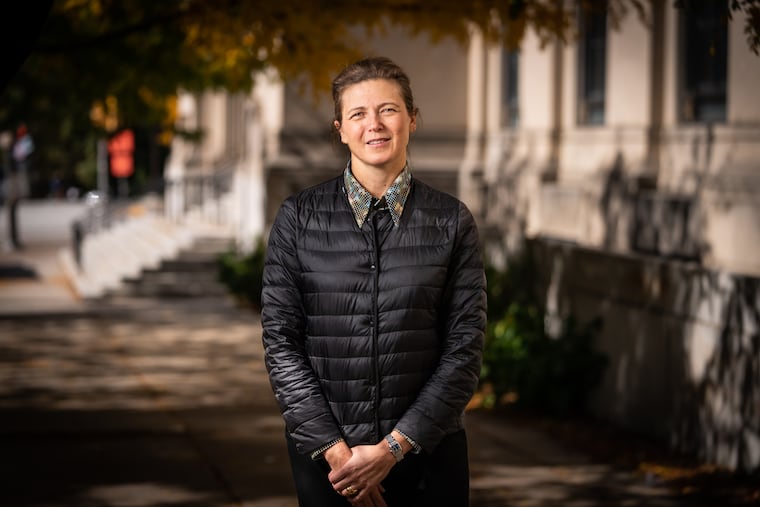After a long strike, Art Museum director Sasha Suda talks about hope, healing, and getting to know Philly
The new head of the Philadelphia Museum of Art looks toward the future with her staff and new city. And the upcoming Matisse exhibit.

On the last day of the third week of Sasha Suda’s new job as director of the Philadelphia Museum of Art, there finally seemed to be good news:
A tentative agreement had been reached with the 180-member PMA Union, which had been on strike since her first day on the job, Sept. 26.
It was a contract the workers had been negotiating for since they unionized about two years before, seeking higher wages and better, more affordable health benefits. And it came practically on the eve of the opening of “Matisse in the 1930s,” a world-class exhibition that was seven years in the making.
Even before a union ratification vote had been taken, Suda was looking forward to the future.
“This is the beginning of a new chapter. There’s going to be a lot of healing that needs to ensue,” said Suda, 42, who came to the museum as no stranger to organized labor. As director of the National Gallery of Canada in Ottawa, she led a unionized museum, and was a union member when she worked as a curator for Toronto’s Art Gallery of Ontario.
“I believe that unions and management will work together toward the future of this institution,” she said in exclusive interview Friday with The Inquirer.
» READ MORE: Philadelphia art museum announces tentative agreement with its striking workers
Friday afternoon, Suda was talking about helping that along by starting to hold weekly breakfasts with staff across all departments, as well as listening sessions, and keeping an office in the museum, not just across the street in the Perelman Building.
Most people would say that harmony will take work. Her predecessor, Timothy Rub, retired in January, when the institution was still feeling the impact of past sexual-misconduct allegations against a former manager and equity issues. Memories of that are still fresh. And in the brief time Suda has been at the helm, union members have criticized her for not reaching out to staff, appearing aloof, and not being involved in labor negotiations. Some pickets have carried placards with messages like “Hey Sasha, Stop Hiding.”
Suda defended what she said was her decision to not personally participate in the bargaining process with the museum’s negotiating team of attorneys and museum officials, who were aided by city officials. However, she maintains she was aware and involved.
“I made a measured and very intentional decision to put my energy into those things that would help us move to the place that we are now,” she said.
“The organization has been in a very fluid situation for quite some time,” she noted. “It would have been irresponsible of me to weigh into decision-making when I have not been on the ground.”
The tentative contract agreement, which will be voted on by the union Sunday, calls for salary increases retroactive to July, and 14% raises over three years going forward, according to union officials. Those officials said the minimum hourly wage will increase from $15 to $16.75 an hour. Workers also won four weeks of paid parental leave and a lowered cost for health benefits.
Part of Suda’s work in the past weeks was helping with the final preparation for the much-anticipated Matisse show, which opens to the general public Thursday. She saw it as fitting that the work in the exhibition represents an artistic rebirth that Matisse realized through the work he created in Philadelphia.
“I feel Matisse’s energy in the moment we’re in now,” Suda said. “We’re going to look back and think about the things we never want to do again or the things we should start, [or] that we should go back to what we lost over time. But we’re also going to be looking forward and creating something new. And what’s really important is no single leader does that. It’s done by a group of people together.”
Indeed, beyond the museum’s historic Matisse show, there is the broad future and the big job Suda was hired for — leading a major arts museum in a multifaceted city like Philadelphia.
“I can’t wait to reopen the doors that face the city and welcome it in,” Suda said. “I mean it literally and metaphorically.”
She plans to meet with people from across the city, creating partnerships that reach into Philadelphia’s diverse neighborhoods and cultures.
“This is about kind of coming down from the hill and listening and learning from the communities that we serve, and continuing the good work that many have been doing at this institution in that direction,” she said.
She’s looking forward to being able to discover even more of the city with her family. She and her husband, a sculptor and metal fabricator, are living in Center City with their 7-year-old twins, a girl and a boy who already love the Philadelphia Zoo.
Their mother, meanwhile, has been charmed by the unmistakable realness of Philly.
“It’s a soulful city,” she said. “The things that make it great aren’t just built from capital and investment. They’re built on history, people’s lived experience, and community-building. It feels deeply authentic as a place made up of many, many different people.”
Suda knows what lies before her now is the challenge of building community and fostering healing with her own staff.
“I completely understand their perspective. I get it,” the director said. “And I was very outcome-driven. Now that we’re here, the next chapter is listening and learning.”